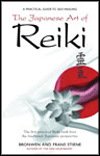Five Elements of Reiki
(Excerpt from The Japanese Art of Reiki by Bronwen and Frans Stiene)
Throughout the system of Reiki’s global trotting and time traveling, just five elements have remained consistent. Many other aspects have been removed, altered or created over the last 100 years. Culturally, the system has adapted itself to various traditions where it has been modified to suit the moral and spiritual values unique to each tradition. Individually, it has also been molded to the tastes and skills of practitioners - and yet these five basic elements have remained. Often in the past, this survival has been reliant on unusual guises that reflect, once again, a cultural or individual influence. Therefore it is easy to understand why for many practitioners today it is a challenge to see the system’s five elements clearly.
It has already been described how the basis of the system was created by a Japanese man, Usui Mikao, in the early 1900s from his own unique experiences. Usui’s blending of esoteric Buddhism called Mikkyô, ancient Shugendô practices, classical samurai teachings, and martial arts know-how produced distinctive teachings. By utilizing traditional approaches in his own inimitable way his intention was to bring about an unmasking, a revelation of what it meant to be human.
Consequently, it is not the energy itself that makes this system unique but the path that is walked. This path developed into one consisting of five elements:
- Reiki Precepts (Gokai)
- Reiki Meditations and Techniques (includes Kokyû Hô)
- Hands-on Healing (Tenohira)
- Reiki Symbols and Mantras (Shirushi and Jumon)
- Reiju and Attunements
A practitioner practices the majority of these elements alone – Gokai, Kokyû Hô, and Shirushi and Jumon. Tenohira, too, is practiced on oneself with the possibility of using it on others. These elements all become part of a personal daily routine coupled with the regular receiving of reiju from a teacher where possible. When brought together each of the elements exerts a separate influence on the practitioner producing a complete system that affects powerful change.
Rewards
Using each of these five elements individually is a strong practice yet when you combine them they produce a complete spiritual teaching that is accessible to everyone. Each element supports the other, filling in the gaps that will exist for different practitioners. No two people have the same needs when learning. For this reason working with all five elements gives each practitioner a greater chance of success. Together these elements create a whole that is firm yet flexible, supporting practitioners on their individual spiritual paths.
If practitioners tread in the footsteps of Usui (metaphorically) with steadfast self-practice they will be assured of discovering deeper, more consistent and lasting results from the system of Reiki.
Application
The five elements appear at different levels of the system of Reiki. Some are repeated as a part of all three levels in varied forms while the importance of others is restricted to just the one level. For clarity, a table is provided that associates the five elements and their uses with specific levels of the system.
Shoden Level I
Purpose
To learn to sense Ki, cultivate Ki and use this knowledge to ground and heal the self (healing others for non-professional use may also be taught).
Five Elements
Gokai – Develop the spiritual and mental connection using gokai (five precepts).
Kokyû hô – Learn kokyû hô (breathing techniques) appropriate to this level to ground the student.
Tenohira –The physical practice of tenohira (palm-healing) on the self/others for the purpose of healing.
Reiju – Receive reiju (a blessing) from a teacher to develop the student’s energetic connection.
Okuden Level II
Purpose
To learn extra tools to strengthen a practitioner’s knowledge and connection with Ki. Using Ki to connect to others not within physical reach for healing (healing others for professional use may also be taught).
Five Elements
Kokyû hô – Learn kokyû hô appropriate to this level to generate more energy.
Jumon and Shirushi – Learn three jumon and three shirushi to aid the student in focusing Ki and ‘becoming’ the appropriate energies.
Reiju – Receive reiju from a teacher to develop the student’s energetic connection.
Shinpiden Level III
Purpose
To focus on furthering personal development and the passing of the system of Reiki on to others.
Five Elements
Kokyû hô – Learn kokyû hô appropriate to this level to advance deeper into personal spirituality.
Jumon and Shirushi – Learn one jumon and one shirushi to aid the student in focusing Ki and ‘becoming’ the appropriate energy.
Reiju – Receive reiju and learn how to perform reiju on others.

